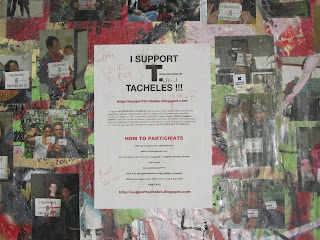
Looking over Granada
Monday, February 13, 2012
I support Tacheles
I fought through every drop of rain and every ball of hail that pelted my cold Californian face, hoping that this walking tour would be worth it. Several times a previous conversation repeated in my head.
“You’re going to freeze to death?” The walking tour guide’s guarantee echoed.
“Why do you say that?”
“Because you’re only wearing a t-shirt and a jacket, and you’re from California.”
I wished she was wrong. I was from California and shouldn’t have underestimated Berlin’s weather in early December. With every slippery step I took on the history laden concrete of Germany’s capital, my soggy socks reminded me that people had to trek in much worse conditions. During World War II, people lived in constant fear. The Battle of Berlin had taken hundreds of thousands of lives. Buildings were blown to pieces and soldiers roamed the streets with unveiled weapons, searching houses unannounced and killing families with unwarranted reason.
I learned of these tragedies in history books and college courses, but when I faced monumental devastation first hand things became real. After seeing the Berlin wall I couldn’t help but feel humbled. I remember walking across the street as the sun was setting. A faint moon appeared in the darkening sky through the shadows of the trees. The Wall stood proud, absorbing the sun as it hit the gleaming water, illuminating the graffiti that exemplifies the battles and struggles the German people endured. The famous wall was resurrected by Eastern Germany in 1961 after the Cold War. I touched the wall and imagined the American and German tanks facing off at Checkpoint Charlie. Suddenly every ball of ice that hit my face seemed harmless compared to the bullets of the StG 44, the most famous assault rifle used in World War II, that penetrated the skin of thousands of innocent people.
“How are you holding up?” My guide screamed through the bellowing wind, interrupting the reenacting terror in my mind.
“Just fine,” I answered with a crooked smile, evoking a surprised, yet excited (and somewhat concerned) expression on my guide’s face.
“Great, you’re going to love this next place.” Once again, the tour guide was right.
We took the metro to the Mitte district and walked to Oranienburger Straße, the old Jewish quarter of Berlin, and waited on a corner until the rain and hail subsided and then crossed with a few umbrellas used more like shields. I glanced up at a huge stencil that read, “How long is now,” a question that plagues Berliners and seems to have been adopted as their motto. I couldn't help but ponder this thought as we stood in front of the large cement building, blanketed with bullet holes and devastation from World War II.
The building was erected in 1908 as a shopping complex with an extended passageway from Friedrichstraße to Oranienburger Straße. This five story mammoth of a building displays several architectural styles such as Modern and Gothic. Its grey hue casts a gloomy plea for freedom. After World War I, an underground chamber was built, and during the World Warn II it was inhibited by Nazis who held French prisoners captive. During the 1980’s, the building was to be demolished. The dome was ripped off and the popular movie theater was shut down. In the 1990’s a group of artist furloughed the demolition. These people were the Kunsthaus Tacheles.
Tacheles is Yiddish for "straight talking," which is what these artists did. They had the building surveyed to evaluate its “architectural integrity,” and found that it was in surprisingly good condition. Shorty after, it was deemed a historical landmark, and temporarily untouchable. It was expanded with apartments where artists lived, until they mysteriously burnt down. There were suspicions that it was to pave way for a new art centre, as there was constant strife between West and East Berlin artists and their visions of the building. After the wall was torn down, a vision was shared and Tacheles made progress to what it has become.
Inside were vibrant colors. Thought evoking graffiti filled every space with new art layered over old. The damp smell proved its prevailing age as the scent of stale cigarettes and beer reminded me that it was not only an artist exhibit, but exhibited by squatters and party animals. Every level held magnificent and original art. The artists barely paid attention to the storms of people entering and exiting, who took pictures in awe that a place like Tacheles exists. It’s the epitome of free expression, all the way up the four sets of stairs until you reach the fifth floor. There is a wall with petitions and hundreds of pictures. A wooded table sits in the middle of this desperate, desolate room. There are more papers strewn across the etched table top, and pens to lend your John Hancock for the freedom of this building. In 2011, an eviction notice was given, but the artists have striven to keep Tacheles alive.
My advice is simple- Get to Tacheles as quickly as you can. It might not be there for long, but will forever pulse through your veins.
Subscribe to:
Post Comments (Atom)


No comments:
Post a Comment